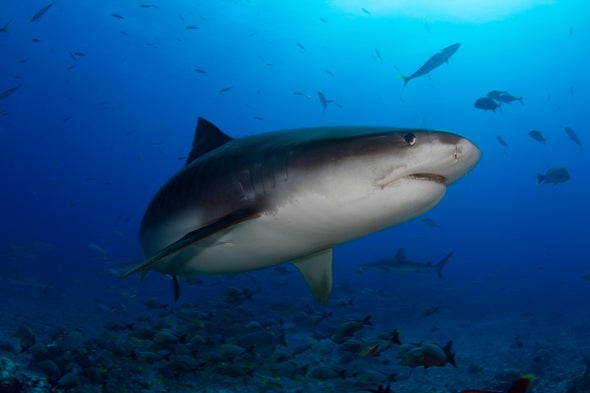科学美国人60秒 SSS 虎鲨正随着海洋变暖而改变它们的出没地(在线收听)
Tiger Sharks, Tracked over Decades, Are Shifting Their Haunts with Ocean Warming
Using a combination of fishing data and satellite tracking, scientists found that the sharks have shifted their range some 250 miles poleward over the past 40 years.
通过综合利用捕鱼数据和卫星跟踪,科学家们发现,在过去40年中,鲨鱼的活动范围向极地移动了约250英里。

虎鲨
Christopher Intagliata: For Scientific American’s 60-Second Science, I’m Christopher Intagliata.
克里斯托弗·因塔利亚塔:这里是《科学美国人》的60秒科学,我是克里斯托弗·因塔利亚塔。
As it happens, tiger sharks have something in common with certain East Coasters.
碰巧的是,虎鲨与某些东岸人有一些共同之处。
Neil Hammerschlag: During the winter, when it’s cold, they snowbird down near the Bahamas and off of Florida. And then, during the summer, they migrate north.
尼尔·哈默施拉格:冬天,当天气寒冷时,他们会在巴哈马群岛附近和佛罗里达州附近过冬。然后,在夏天,它们向北迁徙。
Intagliata: Neil Hammerschlag is director of the Shark Research & Conservation Program at the University of Miami.
尼尔·哈默施拉格是迈阿密大学鲨鱼研究与保护项目的负责人。
He and his colleagues analyzed 40 years of fishing catch data and found that as ocean waters warm, the sharks’ range has shifted some 250 miles to the north. The sharks, it seems, are chasing their preferred water temperatures to the north. They also tracked dozens of tiger sharks with satellite tags for nine years and found similar results.
他和同事们分析了40年来的捕鱼数据,发现随着海水变暖,鲨鱼的活动范围向北移动了约250英里。鲨鱼似乎正在追逐它们喜欢的北方水温。他们还用卫星标签追踪了数十只虎鲨九年,并发现了类似的结果。
Hammerschlag: So taken together, we have several lines of evidence that tiger shark distributions and migrations are changing from ocean warming, causing their distributions and migrations to expand further north. And in these areas, they occur earlier in the year from ocean warming.
哈默施拉格:综上所述,我们有几条证据表明,虎鲨的分布和迁徙正因海洋变暖而发生变化,导致它们的分布和迁徙进一步向北扩展。在这些地区,由于海洋变暖,它们发生在今年早些时候。
Intagliata: Their findings appear in the journal Global Change Biology. [Neil Hammerschlag et al., Ocean warming alters the distributional range, migratory timing, and spatial protections of an apex predator, the tiger shark (Galeocerdo cuvier)]
因塔利亚塔:他们的发现发表在《全球变化生物学》杂志上。[尼尔·哈默施拉格等人,海洋变暖改变了顶级捕食者虎鲨(Galeocerdo cuvier)的分布范围、迁徙时间和空间保护]
This shift matters, Hammerschlag says, because tiger sharks are apex predators, and where they go influences the food web beneath them. The sharks are also moving outside marine protected areas and into places where they’re more vulnerable to commercial fishing.
哈默施拉格说,这种转变很重要,因为虎鲨是顶级捕食者,它们去哪里会影响它们下面的食物链。鲨鱼在离开海洋保护区,进入更容易被商业捕捞的地方。
Hammerschlag: What this points to is: these marine protected areas need to consider current but also future changes in species distribution due to ocean warming. And they have to be adaptive and work with not only having marine protected areas but also other protections, such as catch limits and other types of more traditional species conservation and management tools, in addition to protecting places.
哈默施拉格:这是指:这些海洋保护区需要考虑当前,但未来的变化,由于海洋变暖的物种分布。它们必须适应环境,不仅要有海洋保护区,还要有其他保护措施,比如捕捞限额和其他类型的更传统的物种保护和管理工具,以及保护场所。
Intagliata: Now, if you don’t find the ecological argument convincing, Hammerschlag pointed out one more implication. Although shark bites are relatively rare, he says, if tiger sharks shift their range—and warmer waters draw more bathers to the ocean—that could up the odds of an unfortunate encounter beneath the waves.
因塔利亚塔:现在,如果你不觉得生态学的论点令人信服,哈默施拉格指出了另一个含义。他说,虽然被鲨鱼咬伤的情况相对较少,但如果虎鲨改变活动范围,温暖的海水吸引更多的游泳者到海洋中,这可能会增加在海浪下遭遇不幸的几率。